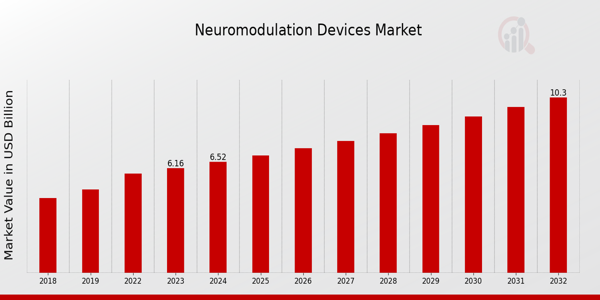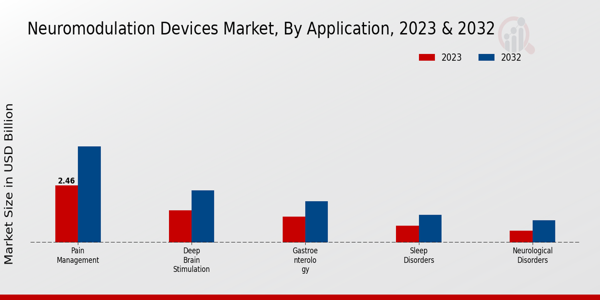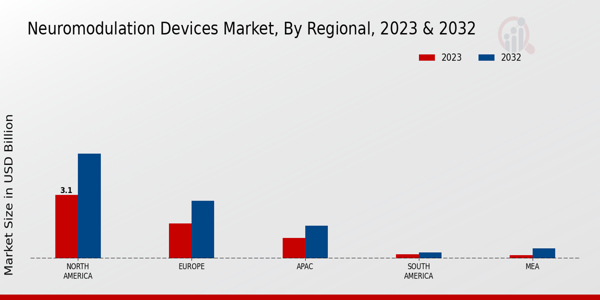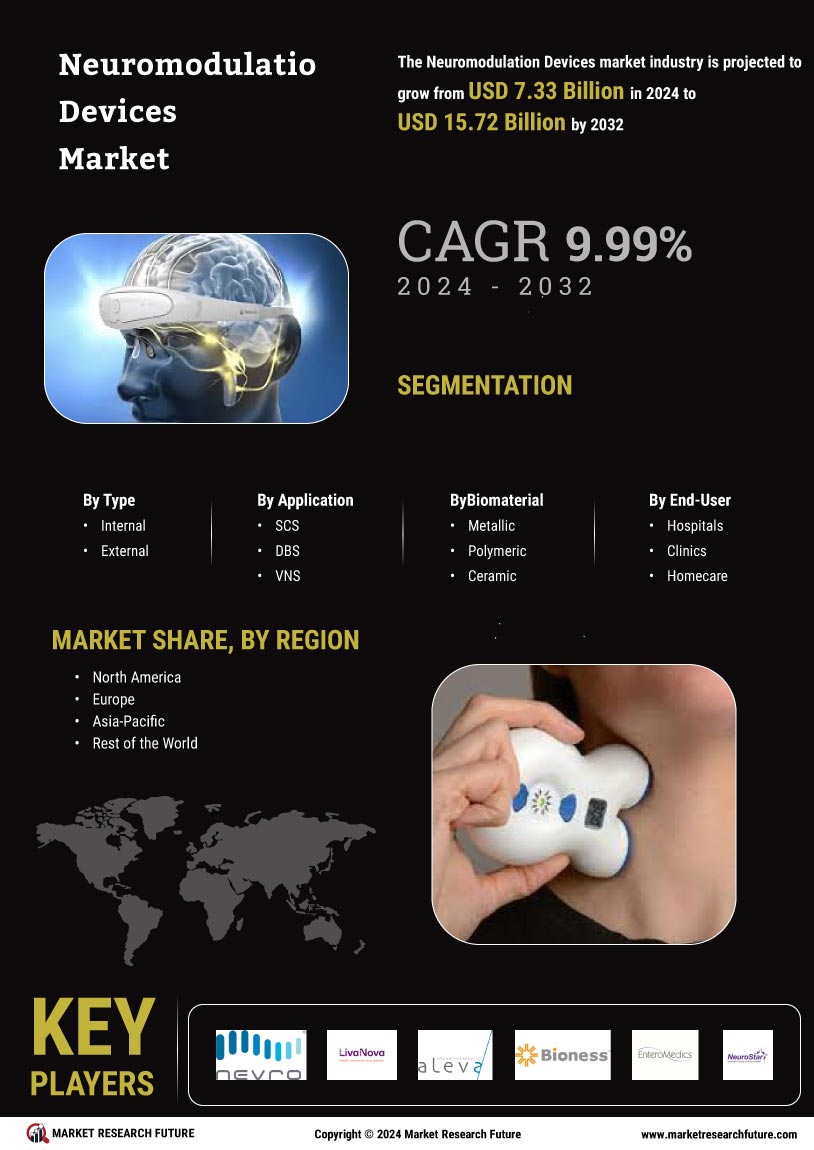Neuromodulation Devices Market Overview
As per MRFR analysis, the Neuromodulation Devices Market Size was estimated at 6.22 (USD Billion) in 2023.The Neuromodulation Devices Market Industry is expected to grow from 6.57(USD Billion) in 2024 to 12 (USD Billion) by 2035. The Neuromodulation Devices Market CAGR (growth rate) is expected to be around 5.62% during the forecast period (2025 - 2035).
Key Neuromodulation Devices Market Trends Highlighted
The Neuromodulation Devices Market is growing at a steady rate because of many important factors. Chronic conditions such as epilepsy, Parkinson's disease, and chronic pain have increased the use of innovative therapies and the need for novel neuromodulation therapies. Furthermore, the precision of modern technology increases the functionality of neuromodulation devices, which improves the outcomes for patients. The shift towards more individualized medicine is increasing the willingness of healthcare providers toward employing these devices. The market still has untapped potential, especially in the development of non-invasive methods of neuromodulation.
These techniques are helpful because they are less invasive, making them more acceptable for both patients and medical professionals. Also, the increasing acceptance of neuromodulation techniques in developing countries represents significant market expansion for other industry leaders. New device development that can reach a broader cross-section of patients is the most recent market trend. The combined efforts of bioengineering departments and medical schools are driving the needed innovations for competition in this market.
Safe and effective treatment also require global government spending on research projects, enabling regulations, and supportive policies for neuromodulation technology. As a result, the Neuromodulation Devices Market will continue to advance due to the need for innovation and effective management of chronic health issues.

Neuromodulation Devices Market Drivers
Increasing Prevalence of Neurological Disorders
The Neuromodulation Devices Market Industry is significantly driven by the rising prevalence of neurological disorders, which is anticipated to escalate due to various demographic changes. According to the World Health Organization (WHO), it is estimated that approximately 1 in 6 people worldwide will experience a neurological disorder at some point in their lives. This includes conditions such as epilepsy, multiple sclerosis, and chronic pain syndromes, contributing to high global disability rates.For instance,
The National Institute of Neurological Disorders and Stroke reports that neurological disorders affect around 50 million people in the United States alone, driving demand for neuromodulation devices that can offer innovative treatments. The rising patient population necessitates the development and availability of effective neuromodulation therapies, thus supporting substantial growth in the Neuromodulation Devices Market, as major players such as Medtronic and Boston Scientific continue to invest heavily in Research and Development initiatives.
Technological Advancements in Neuromodulation Devices
Technological advancements in the Neuromodulation Devices Market Industry are a key driver for market growth. The evolution of innovative neuromodulation technologies, such as deep brain stimulation, spinal cord stimulation, and peripheral nerve stimulation, has been pivotal. According to the Food and Drug Administration (FDA), the approval of new neuromodulation devices has surged, with substantial improvements noted in device efficacy and safety profiles.
For example, the FDA has approved over 25 neuromodulation devices from 2015 to 2020, showcasing a 40% increase in approvals compared to the previous five years. This surge in innovation allows for broader application across various neurological disorders and enhances patient outcomes, pushing major industry players like Abbott and Nevro Corporation to boost their offerings.
Growing Geriatric Population
The increasing geriatric population globally significantly fuels the Neuromodulation Devices Market Industry. It is projected that by 2050, the global elderly population (aged 60 years and older) will reach approximately 2.1 billion, as reported by the United Nations. The elderly are more susceptible to neurological conditions such as Alzheimer’s disease, Parkinson’s disease, and chronic pain, leading to a higher demand for neuromodulation therapies.
This demographic shift results in greater healthcare expenditures on chronic disease management. For instance, it is estimated that the healthcare costs associated with Alzheimer's disease are projected to exceed USD 1 trillion by 2050 in the United States alone, accelerating the necessity for effective treatment solutions provided by neuromodulation devices from organizations like Stryker and LivaNova.
Neuromodulation Devices Market Segment Insights
Neuromodulation Devices Market Application Insights
The Neuromodulation Devices Market is witnessing significant advancements across its various applications, primarily focusing on Chronic Pain Management, Epilepsy, Parkinson's Disease, and Mental Health Disorders. In 2024, the Chronic Pain Management segment is expected to account for a substantial share, valued at 2.8 USD Billion, growing to 5.0 USD Billion by 2035, underscoring its majority holding in the overall market. This prominence is driven by the rising prevalence of chronic pain conditions and the increasing adoption of neuromodulation techniques as a viable treatment alternative.
Epilepsy, holding a market value of 1.5 USD Billion in 2024, is projected to expand significantly to 2.8 USD Billion in 2035. This segment's growth is propelled by the urgent need for effective seizure control options and the continual development of innovative stimulation devices, signifying their importance in the realm of neurological disorders. The Parkinson's Disease segment is valued at 1.2 USD Billion in 2024, with expectations to reach 2.2 USD Billion by 2035, reflecting the rising incidence of this chronic neurological condition and the consequent demand for effective therapeutic interventions.
Lastly, the Mental Health Disorders segment, although smaller at 1.07 USD Billion in 2024, is anticipated to grow to 2.0 USD Billion by 2035, driven by an increasing focus on mental health awareness and the recognition of neuromodulation devices as a promising treatment avenue. Collectively, these segments represent a vital aspect of the Neuromodulation Devices Market, influenced by advancements in technology, growing clinical evidence supporting efficacy, and a growing acknowledgement of the need for effective treatments across various neurological conditions.The trends highlight an evolving landscape where sophisticated neuromodulation options are addressing unmet clinical needs while fostering market growth and opportunities.

Neuromodulation Devices Market Device Type Insights
In the Neuromodulation Devices Market, the Device Type segmentation is a critical aspect driving the industry’s growth. By the year 2024, the overall market is expected to be valued at 6.57 billion USD, reflecting a robust demand for various neuromodulation solutions. Among the diverse categories, Spinal Cord Stimulators and Deep Brain Stimulators are notable for their essential roles in pain management and neurological disorders, respectively.
Transcranial Magnetic Stimulation Devices have gained prominence for their non-invasive approach to treating depression and other mental health conditions, catering to a growing patient base seeking alternatives to traditional therapies.Vagus Nerve Stimulators are significant in managing epilepsy and depression, providing an innovative treatment pathway.
As the Neuromodulation Devices Market continues to evolve, advancements in technology and increasing clinical applications are expected to foster further growth in each of these segments, highlighting the industry's potential and expanding scope in improving patient outcomes across neurological and psychiatric illnesses. The strong emphasis on Research and Development in this sector supports ongoing innovations and leads to enhanced treatment efficacy and safety, positioning the industry for sustained growth.
Neuromodulation Devices Market End Use Insights
The Neuromodulation Devices Market is showing significant growth, with an expected valuation of 6.57 billion USD by 2024 and 12.0 billion USD by 2035. Within the End Use segment, hospitals, neurological clinics, and home healthcare are essential components driving this growth. Hospitals typically serve as primary adopters of neuromodulation devices due to their access to advanced technologies and trained personnel, which ensures effective patient treatment.
Neurological clinics specialize in focused care for patients, often utilizing these devices for chronic pain management and neurological disorders, making them crucial for market evolution.Meanwhile, home healthcare has emerged as an important area, allowing patients to receive treatment in a comfortable setting, facilitating greater patient adherence and satisfaction. This shift is influenced by increasing aging populations and rising incidences of neurological diseases.
Overall, the Neuromodulation Devices Market segmentation highlights the importance of these settings in enhancing patient outcomes and reflecting the ongoing trend towards more personalized and accessible healthcare solutions. Challenges such as regulatory hurdles and the need for skilled operators are present but are outweighed by opportunities for innovation and improved treatment modalities in the market.
Neuromodulation Devices Market Technology Insights
The Neuromodulation Devices Market focused on Technology is experiencing notable expansion, with a projected market value of 6.57 USD Billion by 2024. This growth trajectory is largely driven by advancements in technologies such as Electrical Stimulation, Magnetic Stimulation, and Chemical Stimulation, which play crucial roles in therapeutic applications. Electrical Stimulation dominates the sector due to its effective management of pain and neurological disorders, significantly influencing patient outcomes.
Magnetic Stimulation, known for its non-invasive nature, is increasingly utilized for treatment in psychiatric disorders, highlighting the versatility of neuromodulation technologies.Chemical Stimulation remains vital in therapeutic interventions affecting neuronal activity, offering innovative solutions for chronic ailments. As these technologies evolve, they present various opportunities for enhancing clinical practices while addressing challenges such as regulatory hurdles and the need for extensive Research and Development.
According to market statistics, the Neuromodulation Devices Market aligns with trends towards personalized medicine and improved patient care, ensuring its relevance in the global healthcare landscape.
Neuromodulation Devices Market Regional Insights
The Neuromodulation Devices Market shows a significant division across various regional segments, with North America leading in market value. In 2024, North America is valued at 2.7 USD Billion, which grows to 5.0 USD Billion by 2035, highlighting its major holding in the market due to advanced healthcare infrastructure and a high prevalence of neurological disorders. Europe follows, with a valuation of 1.7 USD Billion in 2024, expected to reach 3.2 USD Billion in 2035, supported by robust regulatory frameworks and increasing adoption of neuromodulation therapies.
The Asia-Pacific (APAC) region is valued at 1.6 USD Billion in 2024, growing to 2.8 USD Billion by 2035, driven by rising disposable incomes and growing awareness of treatment options. In contrast, South America represents a smaller segment with a value of 0.4 USD Billion in 2024 and 0.8 USD Billion in 2035, indicating a nascent market with emerging opportunities.
Meanwhile, the Middle East and Africa (MEA) segment is valued at 0.17 USD Billion in 2024 and expected to reach 0.2 USD Billion by 2035, showcasing a developing interest in innovative medical technologies.The disparities among these regions reflect varying stages of market maturity, healthcare regulations, and technological advancements that play critical roles in shaping the Neuromodulation Devices Market statistics.

Neuromodulation Devices Market Key Players and Competitive Insights
The Neuromodulation Devices Market is witnessing significant advancements driven by technological innovations and increasing acceptance of neuromodulation therapies across various medical disciplines. Various factors contribute to the growth of this market, including a rising prevalence of neurological disorders, chronic pain management needs, and the demand for less invasive treatment options. The landscape of competitive insights reveals a diverse array of companies striving for market dominance through strategic collaborations, extensive research and development efforts, and the introduction of novel technologies.
Key players are focusing on enhancing their product portfolios and tapping into emerging markets, adjusting their strategies to meet changing consumer needs and regulatory requirements across geographies. Moreover, advancements in neuromodulation technologies, such as deep brain stimulation and spinal cord stimulation, are pushing companies to innovate and create solutions that offer better patient outcomes.
Abbott Laboratories stands as a prominent entity within the Neuromodulation Devices Market, showcasing latent strengths in its comprehensive product portfolio and robust market presence. The company's commitment to research and development has enabled it to launch cutting-edge neuromodulation devices that address complex neurological conditions and pain management issues. Abbott Laboratories has established significant brand recognition and has a vast distribution network that allows it to effectively reach healthcare providers and patients worldwide.
Moreover, the firm has invested in clinical studies to substantiate the efficacy and safety of its devices, thereby reinforcing its competitive position. The ability to leverage its extensive clinical expertise and diverse product offerings allows Abbott Laboratories to maintain a competitive edge in a rapidly evolving market.ElectroCore is another noteworthy player in the Neuromodulation Devices Market, primarily known for its innovative approach to neuromodulation technologies. The company focuses on developing non-invasive devices designed to provide therapeutic relief for migraine and cluster headache patients.
ElectroCore's flagship product, a handheld neuromodulation device, showcases its commitment to pioneering solutions that improve patient experience and outcomes. The company is actively expanding its market presence through collaborations and strategic partnerships, enhancing its reach in different regions around the globe. ElectroCore has also pursued mergers and acquisitions to consolidate resources and accelerate growth in the neuromodulation space.
By continuously engaging in clinical research and seeking to broaden its product line, the company strengthens its foothold in the market, asserting itself as a leading provider within the Neuromodulation Devices Market.
Key Companies in the Neuromodulation Devices Market Include:
- Abbott Laboratories
- ElectroCore
- Cytokinetics
- Zynex
- LivaNova
- Stryker
- Stimwave
- Crosstim
- Medtronic
- Nuvectra
- Axonics
- NeuroPace
- HydraFacial
- Boston Scientific
- Inspire Medical Systems
Neuromodulation Devices Market Industry Developments
Significant developments in the Neuromodulation Devices Market include advancements by major companies like Medtronic and Abbott Laboratories, focusing on the expansion of their product portfolios and innovative technologies. For instance, both firms have launched cutting-edge neuromodulation devices to address chronic pain and neurological disorders, enhancing treatment options for patients globally. In September 2023, Abbott Laboratories announced collaboration with NeuroPace to integrate their technologies for advancing brain stimulation therapies.
Additionally, market valuations for companies such as Boston Scientific and Stryker have seen substantial growth due to increasing demand for effective pain management solutions, which has positively impacted the overall market dynamics. In terms of mergers and acquisitions, in June 2023, Inspire Medical Systems acquired Axonics, bolstering its position in the neuromodulation space and expanding its portfolio of innovative treatments.
There have also been notable investments in R&D activities directed at developing next-generation neuromodulation therapies, reflecting a trend towards more personalized and effective treatment methods. Over the past few years, the surge in the prevalence of chronic pain and neurological conditions has driven the market's expansion, emphasizing the need for advanced neuromodulation devices worldwide.
Neuromodulation Devices Market Segmentation Insights
-
Neuromodulation Devices Market Application Outlook
- Chronic Pain Management
- Epilepsy
- Parkinson's Disease
- Mental Health Disorders
-
Neuromodulation Devices Market Device Type Outlook
- Transcranial Magnetic Stimulation Devices
- Spinal Cord Stimulators
- Deep Brain Stimulators
- Vagus Nerve Stimulators
-
Neuromodulation Devices Market End Use Outlook
- Hospital
- Neurological Clinics
- Home Healthcare
-
Neuromodulation Devices Market Technology Outlook
- Electrical Stimulation
- Magnetic Stimulation
- Chemical Stimulation
-
Neuromodulation Devices Market Regional Outlook
- North America
- Europe
- South America
- Asia Pacific
- Middle East and Africa
| Report Attribute/Metric Source: |
Details |
| MARKET SIZE 2023 |
6.22(USD Billion) |
| MARKET SIZE 2024 |
6.57(USD Billion) |
| MARKET SIZE 2035 |
12.0(USD Billion) |
| COMPOUND ANNUAL GROWTH RATE (CAGR) |
5.62% (2025 - 2035) |
| REPORT COVERAGE |
Revenue Forecast, Competitive Landscape, Growth Factors, and Trends |
| BASE YEAR |
2024 |
| MARKET FORECAST PERIOD |
2025 - 2035 |
| HISTORICAL DATA |
2019 - 2024 |
| MARKET FORECAST UNITS |
USD Billion |
| KEY COMPANIES PROFILED |
Abbott Laboratories, ElectroCore, Cytokinetics, Zynex, LivaNova, Stryker, Stimwave, Crosstim, Medtronic, Nuvectra, Axonics, NeuroPace, HydraFacial, Boston Scientific, Inspire Medical Systems |
| SEGMENTS COVERED |
Application, Device Type, End Use, Technology, Regional |
| KEY MARKET OPPORTUNITIES |
Rising prevalence of chronic pain, Increased demand for non-invasive therapies, Technological advancements in implantable devices, Growing geriatric population, Expanding applications in mental health. |
| KEY MARKET DYNAMICS |
Increasing prevalence of neurological disorders, Advancements in technology and innovation, Rising geriatric population, Growing demand for non-invasive treatments, Supportive regulatory environment |
| COUNTRIES COVERED |
North America, Europe, APAC, South America, MEA |
Frequently Asked Questions (FAQ) :
The Global Neuromodulation Devices Market is anticipated to reach a valuation of 6.57 USD Billion in 2024.
By 2035, the Global Neuromodulation Devices Market is expected to be valued at 12.0 USD Billion.
The market is expected to experience a compound annual growth rate (CAGR) of 5.62% from 2025 to 2035.
North America is projected to hold the largest market share, valued at 2.7 USD Billion in 2024.
The Chronic Pain Management application segment is forecasted to reach 5.0 USD Billion by 2035.
Key competitors in the market include Abbott Laboratories, Medtronic, Boston Scientific, and Stryker.
The Epilepsy application segment is valued at 1.5 USD Billion in 2024.
Europe is expected to reach a market size of 3.2 USD Billion by 2035.
The Mental Health Disorders segment is projected to grow to 2.0 USD Billion by 2035.
The APAC region is expected to have a market valuation of 1.6 USD Billion in 2024.


















